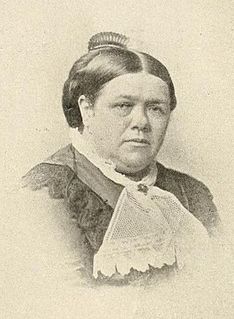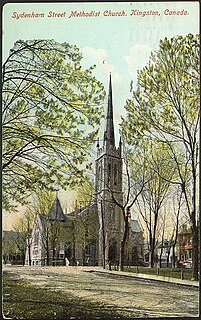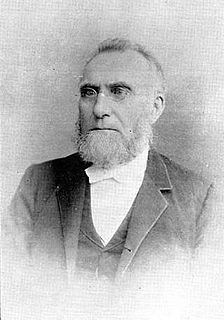
Victoria University is a college of the University of Toronto, founded in 1836 and named in honour of Queen Victoria. It is commonly called Victoria College, informally Vic, after the original academic component that now forms its undergraduate division. Since 1928, Victoria College has retained secular studies in the liberal arts and sciences while Emmanuel College has functioned as its postgraduate theological college.

Adolphus Egerton Ryerson (1803–1882) was a Canadian Methodist minister, educator, politician, and public education advocate in Upper Canada. He was a prominent opponent of the closed oligarchy that ran the province, and coined the term Family Compact for it. He was a prominent contributor to the design of the Canadian Indian residential school system. In the field of education, Ryerson succeeded in winning free elementary education for girls, but opposed the education of women as a class beyond the elementary level due to a belief that their role was to be wives and mothers. Ryerson University is named after him.

The ministry of a deaconess is, in modern times, a non-ordained ministry for women in some Protestant churches to provide pastoral care, especially for other women. The term is also applied to some women deacons in the early church. The word comes from a Greek word, diakonos (διάκονος), for "deacon", which means a servant or helper and occurs frequently in the Christian New Testament of the Bible. Deaconesses trace their roots from the time of Jesus Christ through to the 13th century in the West. They existed from the early through the middle Byzantine periods in Constantinople and Jerusalem; the office may also have existed in Western European churches. There is evidence to support the idea that the diaconate including women in the Byzantine Church of the early and middle Byzantine periods was recognized as one of the major non-ordained orders of clergy.

Nathanael Burwash (1839–1918) was a Canadian Methodist minister and university administrator.
The Methodist Church was the major Methodist denomination in Canada from its founding in 1884 until it merged with two other denominations to form the United Church of Canada in 1925. The Methodist Church was itself formed from the merger of four smaller Methodist denominations with ties to British and US Methodist denominations.
Broadview is a Canadian magazine focussed on national and international issues of spirituality, social justice, and ethical living, as well as United Church of Canada news and perspectives. Formerly the United Church Observer, the magazine was rebranded as Broadview in April 2019. The publication has a paid circulation of 30,000 copies distributed by subscription and newsstand sales. Broadview and Broadview.org are owned and operated by Observer Publications Inc., a non-profit corporation.
Lorne Albert Pierce was a Canadian publisher, editor, and literary critic.
Ryerson Press was a Canadian book publishing company, active from 1919 to 1970. First established by the Methodist Book Room, a division of the Methodist Church of Canada, and operated by the United Church Publishing House after the Methodist Church's merger into the United Church of Canada in 1925, the imprint specialized in historical, educational and literary titles.
The Canadian Review of Music and Art was a Canadian magazine that was published between February 1942 and 1951 by Canadian Review Publishing. The magazine was based in Toronto, Ontario and covered a variety of topics on the arts, from music to painting to sculpture to dance and craft works. Each issue featured several individual Canadian artists and musicians in addition to profiling Canadian arts organizations.

Letitia Youmans was a Canadian school teacher who became an activist for the temperance movement. Youmans founded and served as the first president of the Ontario chapter of the Women's Christian Temperance Union. She also served as editorial writer for the IOGT's Temperance Union.
Toronto City Mission (TCM) is a Christian nonprofit organization that has been the oldest and longest running outreach to people living in poverty in Toronto, Ontario. The organization's headquarters is located in the former city of Scarborough.

Laura Hughes Lunde (1886–1966) was a Canadian feminist, socialist and pacifist. She was an outspoken pacifist in Toronto during World War I (1914–18). Towards the end of the war she married and moved to Chicago, where she was active in numerous civic causes for the rest of her life, notably fighting for women's rights and for improvements to education.

Alice Amelia Chown was a Canadian feminist, pacifist, socialist and author. She was brought up in a strict Methodist family, and remained at home until she was forty attending her mother, who died in 1906. Chown then embarked on a life of travel and involvement in many reform causes. She was an original and iconoclastic thinker, and became one of the leading social feminists of her day. She is best known for her 1921 book The Stairway in which she recounts her life and growing freedom after 1906.

Samuel Dwight Chown was a Methodist minister who led the Methodist Church of Canada into the United Church of Canada in 1925.

Sydenham Street United Church, formerly Sydenham Street Methodist Church, is a church in Kingston, Ontario, Canada that dates to 1852. It was originally a Methodist church, but since 1925 has belonged to the United Church of Canada.
David Savage (1830–1893) was an English-born Methodist minister who worked as a pastor and evangelist in Upper Canada for many years. In the 1880s he adapted techniques from the Salvation Army and began to recruit and train bands of young men or women to assist in his evangelical services. Often they went on to become evangelists themselves.

James Caughey was a Methodist minister and evangelist who was active in the United States, England and Canada. An imposing and effective preacher, he conducted highly emotional revival meetings at which many of his audience were converted or reaffirmed their faith. This brought him into some conflict with the more respectable members of the Methodist church in Britain.

Edward Hartley Dewart was an Irish-born Canadian Methodist clergyman, author and editor. He became a leading figure in the Methodist church and the temperance movement. For several years he edited the official Methodist journal The Christian Guardian. His poetry anthology Selections from Canadian Poets (1864) was the first anthology of Canadian poetry to be published.

Albert Carman was a Canadian Methodist minister and teacher who became head of the Methodist Church in Canada.
William Black Creighton was a Canadian minister, editor, social reformer, and pacifist.
















